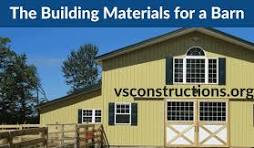
Barns have been an essential structure in agriculture for centuries, serving as shelters for livestock, storage for crops, and hubs for farm activities. Constructing a barn that can withstand the tests of time requires careful consideration of building materials. In this article, we’ll explore the key building materials essential for creating a durable and long-lasting barn.
Wood:
Traditionally, wood has been the primary building material for barn construction due to its availability, versatility, and aesthetic appeal. However, not all wood is created equal when it comes to durability. Selecting high-quality, rot-resistant lumber such as cedar, redwood, or treated lumber is crucial for ensuring the longevity of the structure.
Additionally, the method of wood treatment plays a significant role in enhancing durability. Pressure-treated lumber, which is infused with preservatives to resist decay and insect damage, is commonly used for structural components like posts, beams, and trusses. Properly treated wood can withstand the elements and remain structurally sound for decades.
Additionally, the method of wood treatment plays a significant role in enhancing durability. Pressure-treated lumber, which is infused with preservatives to resist decay and insect damage, is commonly used for structural components like posts, beams, and trusses. Properly treated wood can withstand the elements and remain structurally sound for decades.
Metal:
Metal roofing and siding have become increasingly popular choices for barn construction due to their exceptional durability and low maintenance requirements. Galvanized steel and aluminum are commonly used metals for barn exteriors, offering resistance to rust, corrosion, and fire.
Metal roofing provides superior protection against harsh weather conditions such as heavy rain, snow, and wind, ensuring the integrity of the barn’s interior. Additionally, metal siding is easy to install and clean, making it a practical choice for agricultural buildings that require minimal upkeep.
Concrete:
Concrete is an indispensable building material for barn foundations and flooring, providing stability, durability, and resistance to moisture. A properly poured concrete foundation prevents settling and ensures the structural integrity of the barn for years to come.
Concrete flooring is essential for barns housing livestock, as it offers easy cleaning, prevents moisture buildup, and reduces the risk of bacterial growth. Reinforced concrete floors can withstand heavy loads and resist damage from hooves, machinery, and equipment, making them ideal for high-traffic areas within the barn.
Composite Materials:
Advancements in composite materials have revolutionized barn construction, offering innovative solutions for structural components such as doors, windows, and trim. Fiberglass-reinforced plastic (FRP) and composite lumber are popular choices for these applications due to their durability, low maintenance requirements, and resistance to rot, decay, and pests.
Metal:
Metal roofing and siding have become increasingly popular choices for barn construction due to their exceptional durability and low maintenance requirements. Galvanized steel and aluminum are commonly used metals for barn exteriors, offering resistance to rust, corrosion, and fire.
Metal roofing provides superior protection against harsh weather conditions such as heavy rain, snow, and wind, ensuring the integrity of the barn’s interior. Additionally, metal siding is easy to install and clean, making it a practical choice for agricultural buildings that require minimal upkeep.
Concrete:
Concrete is an indispensable building material for barn foundations and flooring, providing stability, durability, and resistance to moisture. A properly poured concrete foundation prevents settling and ensures the structural integrity of the barn for years to come.
Concrete flooring is essential for barns housing livestock, as it offers easy cleaning, prevents moisture buildup, and reduces the risk of bacterial growth. Reinforced concrete floors can withstand heavy loads and resist damage from hooves, machinery, and equipment, making them ideal for high-traffic areas within the barn.
Composite Materials:
Advancements in composite materials have revolutionized barn construction, offering innovative solutions for structural components such as doors, windows, and trim. Fiberglass-reinforced plastic (FRP) and composite lumber are popular choices for these applications due to their durability, low maintenance requirements, and resistance to rot, decay, and pests.
Composite materials offer the aesthetic appeal of traditional wood without the drawbacks, making them ideal for barns where appearance and longevity are equally important. Additionally, composite materials are lightweight yet strong, making them easy to work with and install in various barn designs and configurations.
Proper Insulation:
Insulation is a critical component of barn construction, providing thermal protection, moisture control, and soundproofing for the interior environment. Fiberglass, foam, and cellulose are commonly used insulation materials, each offering unique benefits depending on the barn’s specific requirements.
Insulating the walls, roof, and doors of the barn helps regulate temperature fluctuations, improve energy efficiency, and create a comfortable environment for livestock, equipment, and farm workers. Proper insulation also reduces condensation and moisture buildup, preventing mold, mildew, and structural damage over time.
Conclusion:
Building a barn that will stand the tests of time requires careful selection of high-quality building materials and meticulous attention to construction techniques. Wood, metal, concrete, composite materials, and insulation each play a vital role in ensuring the durability, longevity, and functionality of the structure.
By investing in durable materials, proper insulation, and expert craftsmanship, farmers can create barns that not only withstand the elements but also provide a safe, comfortable, and efficient space for agricultural activities for generations to come. With careful planning and construction, a timeless barn can serve as the heart of a farmstead, preserving its legacy and heritage for years to come. tion: Insulation is a critical component of barn construction, providing thermal protection, moisture control, and soundproofing for the interior environment. Fiberglass, foam, and cellulose are commonly used insulation materials, each offering unique benefits depending on the barn’s specific requirements.
Insulating the walls, roof, and doors of the barn helps regulate temperature fluctuations, improve energy efficiency, and create a comfortable environment for livestock, equipment, and farm workers. Proper insulation also reduces condensation and moisture buildup, preventing mold, mildew, and structural damage over time










